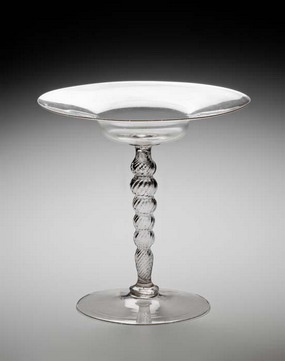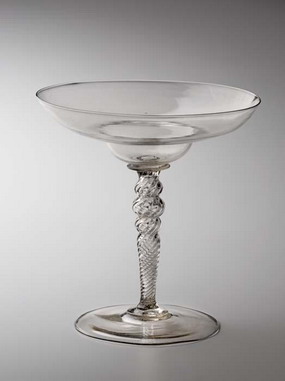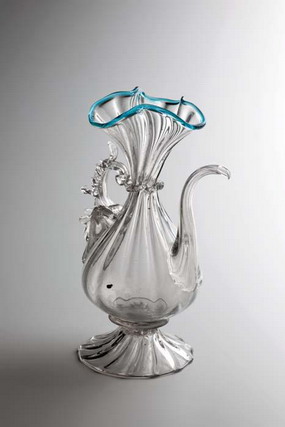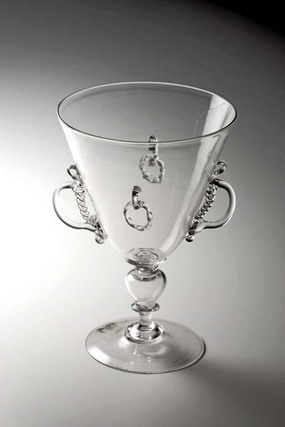
27
小高脚酒杯
意大利,威尼斯,16世纪下半叶
无色透明玻璃,热成形;高12.7 cm
编号 9 593
1906年布拉格的沃伊切克·兰尼捐赠
Small goblet
Italy, Venice, 2nd half of 16th century
Colourless glass, hot-shaped; H. 12.7 cm
Inv. no. 9?593
Donated in 1906 by Vojtěch Lanna, Prague
HB

28
小高脚酒杯
意大利,威尼斯,16世纪下半叶
无色透明玻璃,热成形;高13 cm
编号 2 585
1885年威尼斯的里凯蒂购得
大批量的饮酒器,特别是大酒杯和高脚酒杯,以各种各样的形状面世。16世纪第二、第三个25年间,饮酒器类型开始自成体系,而且大多数当时创造出来的器型被很好地延续下来,直至18世纪。欧洲许多地方的玻璃工坊都仿制威尼斯式玻璃器,这对于玻璃酒杯的断代和产地甄别造成困难,甚至几乎不可能。
Small goblet
Italy, Venice, 2nd half of 16th century
Colourless glass, hot-shaped; H. 13 cm
Inv. no. 2?585
Purchased in 1885 by Ricchetti, Venice
Large quantities of drinking vessels were produced, particularly beakers and goblets that came in a great many different shapes. Their typology had begun to crystallize as early as the second and third quarters of the 16th century and most types created at the time survived well into the 18th century. In many parts of Europe, glasshouses produced fa?on de Venise glass in imitation of Venetian products. It is often difficult, if not impossible, to determine when and where a drinking glass was made.
HB

29
小执壶
意大利,威尼斯,16世纪
无色透明玻璃和蓝玻璃,热成形;高13.5 cm
编号 1 299
1906年布拉格的沃伊切克·兰尼捐赠
Small pitcher
Italy, Venice, 16th century
Colourless and blue glass, hot-shaped; H. 13.5 cm
Inv. no. 1?299
Donated in 1906 by Vojtěch Lanna, Prague
HB

30
带可晃动玻璃环的高脚酒杯
意大利,威尼斯,16世纪
无色透明玻璃,热成形;高12.7 cm
编号 9 569
1906年布拉格的沃伊切克·兰尼捐赠
Goblet with loose rings
Italy, Venice, 16th century
Colourless glass, hot-shaped; H. 12.7 cm
Inv. no. 9?569
Donated in 1906 by Vojtěch Lanna, Prague
HB
31
温格特高脚酒杯
意大利,威尼斯,16-17世纪
无色透明玻璃,热成形;高18.5 cm
编号 9 642
1906年布拉格的沃伊切克·兰尼捐赠
Winget goblet
Italy, Venice, 16th-17th century
Colourless glass, hot-shaped; H. 18.5 cm
Inv. no. 9?642
Donated in 1906 by Vojtěch Lanna, Prague
HB
32
玻璃盘
意大利,威尼斯,16世纪
无色透明玻璃,热成形;直径29 cm
编号 501
1886年布拉格的沃伊切克·兰尼捐赠
这件无色透明玻璃盘由双层玻璃熔合而成,饰有密集的、同心网纹。“嵌网玻璃”是一种威尼斯玻璃,以嵌入不透明的玻璃细丝做成花纹。其它一些玻璃装饰手法包括“嵌线玻璃”、“搓捻玻璃”和“蕾丝玻璃”。
Plate
Italy, Venice, 16th century
Colourless glass with white threads, hot-shaped; diameter 29 cm
Inv. no. 501
Donated in 1886 by Vojtěch Lanna, Prague
This colourless-glass dish with an overlayed rim is decorated with a dense, concentric network. Vetro a reticello is one of the many types of Venetian products decorated with opaque glass canes; other types are known as vetro a fili (glass with threads), vetro a retorti (glass with twists) and vetro a filigrana (filigree glass).
HB
33
有盖高脚酒杯
意大利,威尼斯或威尼斯式,16世纪末
饰有白色玻璃丝的无色透明玻璃,热成形,镀金托架;高40 cm
编号 30 464
1948年购自布拉格的V·霍热什拍卖会
这件“蕾丝玻璃”作品镶着錾刻精细的黄铜托,上部为喇叭形高盖、扁圆形盖钮,下部为外撇的底座。中部为杯身,上呈圆柱形,下渐收成五个阶梯式圆环。蕾丝花纹从上到下遍布杯身,呈垂直分布,而在杯盖上则斜向交缠。蕾丝花纹由白色条纹和网状细条纹构成,并相互间隔。德国科堡藏有一件类似的酒杯。
Covered goblet
Italy, Venice or fa?on de Venise, end of 16th century
Colourless glass with white threads, hot-shaped, gilded mounting; H. 40 cm
Inv. no. 30?464
Purchased in 1948 at the V. Ho?ej? Auction, Prague
Decorated in the filigrana style and with a delicately chased brass mount, this tall-lidded goblet is set on a flaring base and flattened knop. Cylindrical in its upper section, the bowl tapers down in five, cascading rings. The filigree pattern runs vertically on the goblet, with oblique twists on the cover, which is composed of full, white strips that alternate with crisscross bands. A similar goblet is preserved in a collection housed in the Veste Coburg, Germany.
HB
34
高脚酒杯
意大利,威尼斯,16世纪
饰有白色玻璃丝的无色透明玻璃,热成形;高26 cm
编号 8 684
1906年布拉格的沃伊切克·兰尼捐赠
Goblet
Italy, Venice, 16th century
Colourless glass with white threads, hot-shaped; H. 26 cm
Inv. no. 8?684
Donated in 1906 by Vojtěch Lanna, Prague
HB
35
高脚碗
意大利,威尼斯,16-17世纪
饰有白色玻璃丝的无色透明玻璃,热成形;高14 cm
编号 9 687
1906年布拉格的沃伊切克·兰尼捐赠
Footed bowl
Italy, Venice, 16th-17th century
Colourless glass with white threads, hot-shaped; H. 14 cm
Inv. no. 9?687
Donated in 1906 by Vojtěch Lanna, Prague
HB
36
浅碗
意大利,威尼斯,18世纪
饰有白、红两色玻璃丝的无色透明玻璃,热成形;高17.8 cm
编号 16 956
1932年由斯图加特的古斯塔夫E.帕兹奥瑞克捐赠
这只浅碗饰有红、白两色玻璃“蕾丝”,下承铃铛形矮足。古斯塔夫·E·帕兹奥瑞克是布拉格人,著名的欧洲玻璃器鉴赏家,藏有大量高品质的威尼斯玻璃器。1905年至1930年间,他是德国斯图加特的符腾堡州立博物馆馆长。
Tazza
Italy, Venice, 18th century
Colourless glass with red and white threads, hot-shaped; H. 17.8 cm
Inv. no. 16?956
Donated in 1932 by Gustav E. Pazaurek, Stuttgart
This shallow bowl decorated with red and white filigree threads is mounted on a low, bell-shaped foot. A large number of fine-quality Venetian products come from the collection of Gustav E. Pazaurek, a native of Prague and a distinguished connoisseur of European glass. In 1905–1930, Pazaurek was the director of the Württemberg State Museum in Stuttgart (Germany).
HB
37
高足酒杯
意大利,威尼斯,18世纪
饰有白、红两色玻璃丝的无色透明玻璃,热成形;高11.6 cm
编号 94 242
1971年由莱昂·邦迪基金转让而购得
Footed beaker
Italy, Venice, 18th century
Colourless glass with white and red threads, hot-shaped; H. 11.6 cm
Inv. no. 94?242
Acquired in 1971 by transfer from the Leon Bondy Fund
HB
38
碗
意大利,威尼斯,17世纪上半叶
玛瑙玻璃(夹着黄、蓝、绿三色绞胎纹的红褐色玻璃),热成形;直径5.5 cm
编号 601
1886年购自L.&L.汉堡公司拍卖会
玛瑙玻璃,又称人造玉髓,最早出现于15世纪晚期。然而金星玻璃(含有铜、金或铬氧化物等发光包裹体)的发明却要归功于乔万尼·达杜因,他的著述中记录了已知最早的金星玻璃配方。
Bowl
Italy, Venice, 1st half of 17th century
Agate glass (reddish-brown glass decorated with marbled yellow, blue and green striations), hot-shaped; diameter 5.5 cm
Inv. no. 601
Purchased in 1886 at the L. & L. Hamburger Auction
Agate glass, known as calcedonio (chalcedony), was first made in the late 15th century. However, the invention of aventurine – a type of glass with sparkling inclusions of copper, gold or chromic oxide – is attributed to Giovanni Darduin (1586–1654), whose recipe book preserves the earliest known recipe for the manufacture of this type of glass.
HB
39
双把碗
意大利,威尼斯,约17世纪
玛瑙玻璃(夹着黄、蓝、绿三色绞胎纹的红褐色玻璃),热成形;高4.6 cm,直径10 cm
编号 9 788
1906年布拉格的沃伊切克·兰尼捐赠
Bowl with two handles
Italy, Venice, c. 1700
Agate glass (reddish-brown glass decorated with marbled yellow, blue and green striations), hot-shaped; H. 4.6 cm, diameter 10 cm
Inv. no. 9?788
Donated in 1906 by Vojtěch Lanna
HB
(3) 欧洲威尼斯式热成形玻璃器European Hot-Shaped Glass in Venetian Style
40
带锡盖的有柄大杯
波希米亚,17世纪
饰有白色玻璃丝的无色透明玻璃,镶锡托;高22.5 cm
编号 2 915
1888年购自美茵河畔法兰克福,罗斯奇和齐默尔曼拍卖会
Mug with tin lid
Bohemia, 17th century
Colourless glass with white threads, tin mounting; H. 22.5 cm
Inv. no. 2?915
Purchased in 1888 at the Auction Roesch & Zimmermann, Frankfurt am Main
HB
41
温格特高脚酒杯
荷兰(威尼斯式),16世纪末至17世纪初
无色和蓝色透明玻璃,热成形;高33 cm
编号 5 213
1893年购得(最初为斯皮策先生藏品)
Winget goblet
Holland (fa?on de Venise), end of 16th century –beginning of 17th century
Colourless and blue glass, hot-shaped; H. 33 cm
Inv. no. 5?213
Purchased in 1893 (originally in the collection of Mr. Spitzer)
HB
42
温格特高脚酒杯
荷兰(威尼斯式),16世纪末至17世纪初
无色和蓝色透明玻璃,热成形;高20 cm
编号 3 899
1891年购自诺雷拍卖会
威尼斯和阿尔塔雷的玻璃大师们于16世纪开始移民欧洲其他城市,因而推动了玻璃工艺的流传。最早生产威尼斯式玻璃器的地区是16、17世纪的荷兰南部。从那里,意大利工匠们又继续迁往低地国家的北部地区以及德国、英格兰、西班牙和中欧。荷兰南部的玻璃厂开发了石灰玻璃的高脚酒杯。它们独具特色,高脚部分用玻璃细条复杂地编成辫状,并装饰着粘花,当时的法文分别称之为“蛇玻璃”和“花玻璃”。
Winget goblet
Holland (fa?on de Venise), end of 16th century–beginning of 17th century
Colourless and blue glass, hot-shaped; H. 20 cm
Inv. no. 3?899
Purchased in 1891 at the Nollet Auction
In the 16th century, glass masters of Venice and Altare began to emigrate to various parts of Europe, bringing with them their “know-how”. The earliest manufacture of glass in the “style of Venice” (fa?on de Venise) was introduced in the 16th and 17th centuries in the southern part of the Netherlands. From there, the Italian glassmakers moved further on to the United Provinces in the northern regions of the Low Countries, as well as to Germany, England, Spain and central Europe. Glassworks in southern Netherlands developed the distinctive types of tall goblets made of chalk glass.These vessels featured intricately plaited stems and applied prunts, which in contemporary records were referred to in French as “verres à serpent”(glass with snakes) and “verres à fleur” (glass with flowers).
HB
43
温格特高脚酒杯
荷兰(威尼斯式),16世纪末至17世纪初
无色和红色透明玻璃,热成形;高27 cm
编号 9 649
1906年布拉格的沃伊切克·兰尼捐赠
Winget goblet
Holland (fa?on de Venise), end of 16th century–beginning of 17th century
Colourless and red glass, hot-shaped; H. 27 cm
Inv. no. 9?649
Donated in 1906 by Vojtěch Lanna, Prague
HB
44
温格特高脚酒杯
南波希米亚,霍基纳-沃达(今名:赫尔布伦),1650-1675
无色透明玻璃,热成形;高31.2 cm
编号 2 273
1887年从维也纳的M.布鲁姆处购得
这种威尼斯式温格特高脚酒杯与当地布奎伯爵家族档案中赫尔布伦玻璃器的描述相符,这些档案现藏崔邦国家档案馆。档案中有一份1650年生产玻璃器的清单,其中记载了酒杯的高脚先由几股玻璃搓捻而成,而后高脚两翼再粘上毒蛇、刺猬和雄鹰等花纹,说明受西欧影响的晚期威尼斯式玻璃早于17世纪中期就在波希米亚生产。这类产品因其特别的制作工艺而在德语和法语中被称为“蛇玻璃”。
Winged goblet
Southern Bohemia, Hojná Voda (Heilbrunn), 1650–1675
Colourless glass, hot-shaped; H. 31.2 cm
Inv. no. 2?273
Purchased 1887 from M. Blum, Vienna
The form of this winged goblet made in Venetian style corresponds to the descriptions related to the Heilbrunn glassworks, which are recorded in the former family archives of the noble family of Buquoy, now housed in the State Archives in T?eboň. The 1650 glassworks inventory lists goblets of elaborate shapes made of twisted canes and applied “wings” in the form of snakes, hedgehogs and eagles. These descriptions document the fact that glass in “late Venetian style” and influenced by Western European examples was already made in Bohemia around the mid-17th century. These products were also referred to as “snake glass” (Schlangenglass in German, verres à serpent in French).
HB
45
海豚形烛台(桌面装饰品)
南波希米亚,新赫拉迪(格拉岑),可能在卢日尼采(卢日尼兹),约1700年
带红宝石玻璃丝的无色透明玻璃,热成形;高20 cm
编号9 798
1906年布拉格的沃伊切克·兰尼捐赠
这件吹塑成形的海豚形烛台相对忠实地再现了法国奥尔良皇室玻璃器中的乳白玻璃桌饰。伯纳德·佩罗(1638–1709)出生于意大利热那亚附近的阿尔塔雷,擅长制作高品质的水晶玻璃、红宝石玻璃和乳白玻璃制品。
Table decoration (candlestick) in the shape of a dolphin
Southern Bohemia, Nové Hrady (Gratzen), probably Lu?nice (Luschnitz), c. 1700
Colourless glass with ruby threads, hot-shaped; H. 20 cm
Inv. no. 9?798
Donated in 1906 by Vojtěch Lanna
This mould-blown figure of a dolphin is a relatively faithful imitation of milk-glass centrepieces produced by the Glasshouse of Bernard Perrot, Verrerie Royale d’Orléans, in France. Bernard Perrot (1638–1709), a native of Altare near Genoa, Italy, was an accomplished manufacturer of high-quality crystal, ruby and opal glasses.
HB
46
戏法杯
南波希米亚,新赫拉迪(格拉岑),可能在波霍日(布哈斯),18世纪上半叶
带红宝石玻璃丝的无色透明玻璃,热成形;高18 cm
编号16 915
1932年由斯图加特的古斯塔夫E.帕兹奥瑞克捐赠
这个带把大杯有一个怪异的流,沿颈部装饰粘花,属于魔术杯一类,非常有趣,又称戏法杯,用来让使用者惊讶和消遣。
Puzzle mug
Southern Bohemia, Nové Hrady (Gratzen), perhaps Poho?í (Buchers), 1st half of 18th century
Colourless glass with ruby threads, hot-shaped; H. 18 cm
Inv. no. 16?915
Donated in 1932 by Gustav E. Pazaurek, Stuttgart
This mug with a handle and a peculiar spout, decorated with prunts along the neck, falls within the group of so-called jocular or magical glass, termed “trick glass” (Vexierglass in German), which was intended both to surprise and amuse its users.
HB
47
篮子
南波希米亚,新赫拉迪(格拉岑),18世纪上半叶
带红宝石玻璃丝的无色透明玻璃,热成形;高9 cm,直径13.5 cm
编号 72 410
1968年购自布拉格的一家首饰店
Basket
Southern Bohemia, Nové Hrady (Gratzen), 1st half of 18th century
Colourless glass with ruby threads, hot-shaped; H. 9 cm, diameter 13.5 cm
Inv. no. 72?410
Purchased in 1968 from a Klenoty shop, Prague
HB
48
水壶
西班牙,加泰罗尼亚,18世纪
带白色嵌线的无色透明玻璃,部分蓝色透明玻璃,热成形;高26.5 cm
编号 17 017
1932年由斯图加特的古斯塔夫·E·帕兹奥瑞克捐赠
西班牙玻璃制品的灵感也来自威尼斯玻璃,但一眼望去与同时代欧洲的其它类型很是不同。这件水壶的造型反映了西班牙传统的混合风格——兼具基督教、犹太教和阿拉伯文化三元素,当然也明显受到了威尼斯风格的影响。
Cantir
Spain, Catalonia, 18th century
Colourless and blue glass with white trails, hot-shaped; H. 26.5 cm
Inv. no. 17?017
Donated in 1932 by Gustav E. Pazaurek, Stuttgart
Spanish glass, inspired by Venetian examples, differs at first glance from other types of contemporary European glass. Its shape reflects the traditional blending of Christian, Judaic and Arab cultures, and, clearly, the influence of Venetian products.
HB
49
酒壶
西班牙,加泰罗尼亚,17世纪末至18世纪初
带白色嵌线的无色透明玻璃,热成形;高28.5 cm
编号 94 207
1971年由莱昂·邦迪基金转让而购得
这是一款极具特色的西班牙酒器,既有玻璃的也有其它材质的。今天,这种酒器被用于餐馆和酒庄门口以欢迎顾客。
Porrón
Spain, Catalonia, end of 17th centurybeginning of 18th century
Colourless glass with white threads, hot-shaped; H. 28.5 cm
Inv. no. 94?207
Acquired in 1971 by transfer from the Leon Bondy Fund
This is a distinctly Spanish type of wine vessel, made also in other materials. To this day, the porrón is used to welcome visitors at entrances to restaurants and bodegas.
HB
50
执壶
西班牙,加泰罗尼亚,可能为巴塞罗那,16世纪末至17世纪初
带白色嵌线的无色透明玻璃,部分蓝色透明玻璃,热成形;高20.2 cm
编号 9 678
1906年布拉格的沃伊切克·兰尼捐赠
Pitcher
Spain, Catalonia, probably Barcelona, end of 16th centurybeginning of 17th century
Colourless and blue glass with white trails, hot-shaped; H. 20.2 cm
Inv. no. 9?678
Donated in 1906 by Vojtěch Lanna
HB